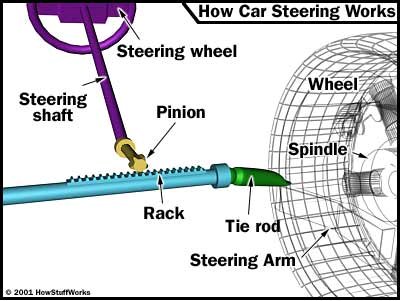Have you ever wondered why buses and big rigs have those huge steering wheels, sometimes with the little swivel knob? It’s because it takes a lot more effort and turning of the steering wheel to navigate a simple turn and the larger steering wheel makes the job easier. Maybe your car or pickup is starting to feel like you need a bigger steering wheel? Sometimes our power steering goes and you really see what it takes to park a car without power steering! You wrestle, you twist, you grunt and groan.
At Good Works Auto Repair, we won’t sell you one of those big-rig steering wheels, but we will take care of your power steering. This week, let’s take a look at your car’s steering system. We all know that when you turn the wheel, your tires turn – but there’s a lot that happens in between. First, let’s back up and talk a little geometry. Imagine doing a U-turn. Your inside tires obviously turn a tighter circle than your outside tires – if all four tires were in a locked position and could not turn separately from each other, you could only go in a straight line. This ability to work independently is allowed by the steering linkage.
Your vehicle is likely either steered by a rack-and-pinion system, the most common in cars, small trucks, and SUVs. The rack-and-pinion gearset is housed in a metal tube with each end of the rack protruding. A tie rod connects to each end of the rack and to the wheel mechanism.
The pinion gear spins as you turn the steering wheel, moving the rack, which in turn moves the tie rod, steering arm, and eventually the wheel. Of course, to make all this work more easily we add a hydraulic or power steering system which is comprised of a series of valves, pumps, pistons, and fluid. Whew, all that, but really a simple system.
The question is, however, how do you maintain this power steering system? Basically, it’s just draining or flushing out the old power-steering fluid, using special cleaners to remove the build-up gunk within the system, and adding fresh power steering fluid. This is an important aspect of auto maintenance because over time, the seals and other internal power-steering components break and down contaminate the fluid, which makes the pump work harder – and eventually wear out. Changing your fluid is much less expensive than replacing the pump or rack! As with most maintenance tasks, you’ll find the recommended intervals in your owner’s manual, but generally every 30,000 miles is a safe bet.
Think your power steering may need more attention than the regularly scheduled maintenance? If you hear a whining or moaning noise when you turn, your pump may be about to fail. Or, if you notice a leak of any type of fluid, you should check and top off, your power steering fluid if necessary.
Not the mechanical sort? Visit your local auto repair facility in Mesa, AZ or Tempe, AZ. You can even download a coupon) to help cover your preventative maintenance costs by clicking here. As always, drive safe!
Schedule My Appointment Now!

